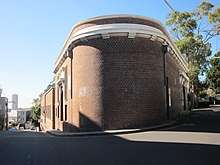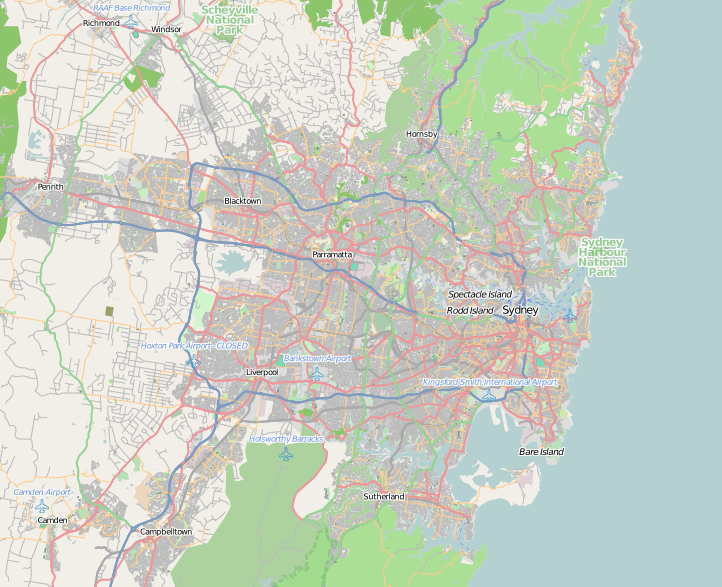Paddington Substation
Paddington Substation is a heritage-listed electrical substation built in 1926 and located at 1 Young Street, Paddington in the Municipality of Woollahra local government area of New South Wales, Australia. It is also known as Substation #342 Paddington 33Kv Zone. The property is owned by Ausgrid, an agency of the Government of New South Wales. It was added to the New South Wales State Heritage Register on 2 April 1999.[1]
| Paddington Substation | |
|---|---|
 Paddington Substation, 1 Young Street, Paddington New South Wales | |
| Location | 1 Young Street, Paddington, Municipality of Woollahra, New South Wales, Australia |
| Coordinates | 33°53′03″S 151°13′31″E |
| Built | 1926 |
| Architectural style(s) | Interwar Free Classical |
| Owner | Ausgrid |
| Official name: Paddington Substation; Substation #342 Paddington 33Kv Zone | |
| Type | State heritage (built) |
| Designated | 2 April 1999 |
| Reference no. | 939 |
| Type | Electricity transformer/substation |
| Category | Utilities - Electricity |
 Location of Paddington Substation in Sydney | |
History
Paddington
This suburb, which took its name from the London borough, lies in what were once paddocks adjacent to Victoria Barracks. It was the first of the early Sydney suburbs that was not self-sufficient - its inhabitants, unlike those of Balmain or Newtown, where work was available in local industries, had to go away each day to their places of employment. Development of the Eastern Suburbs (Edgecliff, Double Bay, Point Piper and Woollahra) surrounded this area with wealthy people's homes so this small hilly suburb lost all hope of harbour views.[1]
The area developed after a road was constructed to link up with a pilot station that was to be built at Watson's Bay (South Head Road). John Palmer, the settlement's commissary, refused to allow people to cross his land grant ('Woolloomooloo'), so the road had to follow a roundabout way through Paddington to bypass his 40 hectares (100 acres).[1] Only a handful of workers lived in the area, and it was not until 1838, when it was decided to build a new military barracks in Paddington, that life came to the area.[1] From 1848 when Victoria Barracks had been opened (designed by Lt.-Col.George Barney) and homes for the soldiers and their families had been erected, Paddington began to assume a real identity...The (barracks site) land was sandy - in fact a huge sandhill was located on the western side of the Greens Road area, and the foundation trenches had to be dug very deep, to locate firm stone for the foundations. Stone was mostly quarried in the area: the stonemasons were free settlers who had worked on erection of the Customs House at what was then Semi-Circular Quay.[1]
Once the soldiers and their families moved here, shopkeepers followed. Builders moved into the area and put up 3,800 houses between 1860 and 1890. These terraces give today's Paddington its air of individuality. The first school in the area was opened in the Presbyterian manse in Oxford Street, built in 1845.[1] It is hard to imagine that in 1822 the mansion Juniper Hall (the opposite southern corner of Oxford Street from the Reservoir site) stood alone, without the many neighbours it has today. Set in a flagged garden, it had attic windows that gave panoramic views to Rushcutters Bay and Botany Bay. Juniper Hall was built for Robert Cooper, distiller and emancipist merchant, who with partners James Underwood and Francis Ewen Forbes, had received 40 hectares (100 acres) from Governor Brisbane in c. 1818, covering the whole of north Paddington, and they agreed to erect three mansions and a distillery there. A distillery was built at the foot of Cascade Street near Taylor Square and Cooper bought out his partners, and only Juniper Hall was erected. The Coopers were part of the social scene of their day and entertained many notables of that time.[1]
Today few of the area's original working class residents remain, as the suburb's proximity to the city has made it popular with business and professional people who prefer inner-city living in this historic area. The shopping centre, concentrated on the north side of Oxford Street, has also changed from one serving local needs to one of cafes, speciality shops and boutiques. Much of this is related to the changing population and the Village Bazaar, or Paddington Markets. The bazaar, which has operated since the mid 1970s, draws visitors from all over the city and has contributed to Paddington's development as one of Sydney's favourite tourist spots, along with Bondi Beach and The Rocks.[1][2]
Substation
The Paddington Zone substation is a purpose designed and built structure dating from 1926.[1]
Description
The Paddington Zone substation is a fine and excellent example of an unusual tuck pointed face brick building with a curved wall following its corner position. Designed in the Interwar Free Classical style it features a dominant classical rendered cornice below the parapet, a pediment above the central entrance dorrway flanked by multi paned windows. It makes a considerable contribution to the character of the Paddington Streetscape. It is located in the Paddington Urban Conservation Araea as listed by the National Trust of Australia. The Paddington Zone substation is constructed using tuck pointed face brick work and features a bold rendered cornice below the parapet. External materials include face brick, cement render, and steel roller shutter.[1]
Condition
As at 10 November 2000, the condition was good.
Heritage listing
The Paddington Zone substation is a fine rare rare and representative example of an externally intact Interwar Functionalist building located within Paddingtom Urban Conservation Area as listed by the National Trust. It makes a substantial contribution to the character of the streetscape in the paddington area. It has considerable architectural significance on a state level, as the only known example of its kind in the Sydney area.[1]
Paddington Substation was listed on the New South Wales State Heritage Register on 2 April 1999.[1]
External links

References
- "Substation". New South Wales State Heritage Register. Office of Environment and Heritage. H00939. Retrieved 2 June 2018.
- Pollen, 1988, 195-7.
Bibliography
- North, Maclaren. Paddington Zone Substation NO. 342 - Conservation Management Plan.
- Schwager Brooks and Partners (1994). Sydney Electricity Section 170 Register.
Attribution
![]()